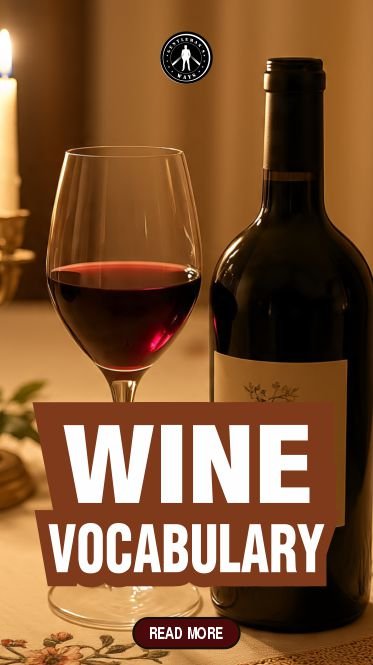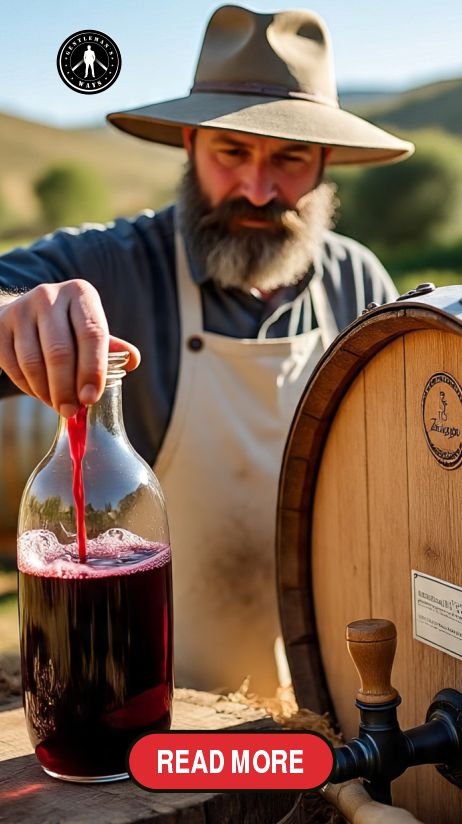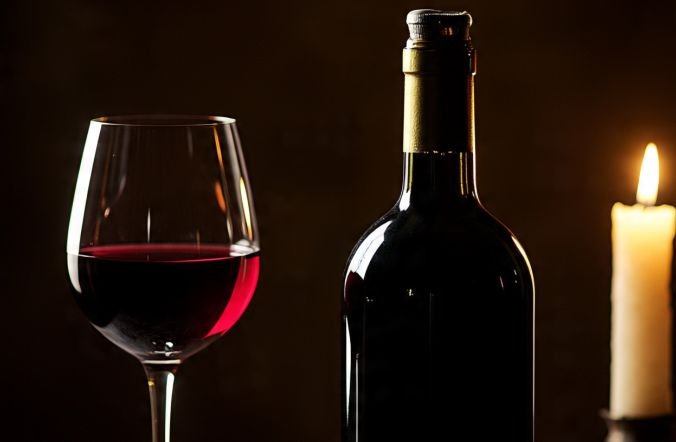Common wine terms help every gentleman understand labels, speak confidently at the table, and enjoy wine with true appreciation and refined taste.
If you enjoy good food, hosting friends, or simply relaxing with a fine glass of wine, knowing common wine terms gives you confidence and class.
It helps you understand labels, speak with ease at restaurants, and have meaningful conversations with other wine lovers.
When you know how to describe aroma, texture, or taste, you connect more deeply with what’s in your glass.
You also make better choices when pairing wine with food or selecting a bottle for any occasion.
Beyond flavor, wine carries culture, tradition, and craftsmanship. Knowing the language behind it lets you appreciate that story.
This guide introduces the wine terms glossary every gentleman should know to refine their taste and confidence in every pour.

Table of Contents
- Why Wine Vocabulary Matters for a Gentleman
- Basic Wine Tasting Terms
- Wine Production and Label Terms
- Wine Serving and Aging Terms
- Descriptive Wine Terms Used by Sommeliers
- How to Sound Like a Gentleman When Talking About Wine
- Conclusion: Building Confidence in the Language of Wine
- Frequently Asked Questions
Why Wine Vocabulary Matters for a Gentleman
Knowing wine vocabulary is more than sounding refined. It’s about confidence, connection, and appreciation.
When you understand the language of wine, you bring substance to your conversations and charm to your presence at any table.
It Reflects Your Confidence and Class
When you describe a wine from the wine terms glossary, you show that you know what you are talking about.
Words like aroma, finish, or body give weight to your opinions.
This confidence sets you apart when ordering at a restaurant, hosting guests, or joining wine conversations.
It shows self-assurance without pretension.
It Helps You Make Better Wine Choices
Knowing how to describe flavors and textures helps you choose wines that suit your taste.
When you understand words like dry, fruity, or oaky, you can express what you like and avoid what you don’t.
This knowledge guides your selections, whether you’re buying a bottle or pairing wine with dinner.
It Deepens Your Appreciation of Wine
Wine vocabulary gives meaning to what you taste. Instead of saying a wine “tastes nice,” you can talk about its layers, balance, or finish.
You start noticing details, like how acidity adds freshness or tannins create structure.
This awareness transforms drinking wine into a richer, more mindful experience.
It Strengthens Your Social Presence
When you can speak clearly about wine, you connect more easily with others.
It turns small talk into interesting conversations and adds charm to dinner gatherings.
People enjoy listening to someone who expresses knowledge with ease and warmth.
For a gentleman, this ability opens doors to deeper connections and lasting impressions.
It Connects You to Culture and Tradition
Every wine term carries a story of place, craft, and heritage.
Knowing these words links you to the regions and people behind each bottle.
From French vineyards to Italian cellars, your grasp of wine language allows you to appreciate its culture with respect and curiosity.
This connection adds depth to your experiences and conversations.
Related Posts
The Sparkling Wine: Everything to Know
White Wine Characteristics and Types
Types and Characteristics of Rose Wine
Old, New and Emerging Wine Regions Around the World
Basic Wine Tasting Terms
Knowing basic wine tasting terms helps you describe what you taste and understand what makes each wine different.
When you grasp these words, you can enjoy wine with deeper appreciation and confidence.
Aroma and Bouquet
When you lift your glass, the first thing you notice is the scent. Aroma comes directly from the grapes and is strongest in young wines.
You might smell fruit, flowers, or herbs.
Bouquet, on the other hand, develops with age and fermentation. It reveals deeper notes like leather, spice, or earth.
The difference between aroma and bouquet tells you how the wine has matured and what story it carries in every sip.
Body
The body describes how a wine feels in your mouth. A light-bodied wine feels smooth and crisp, like a Pinot Grigio, while a full-bodied wine, such as Cabernet Sauvignon, feels rich and dense.
You can think of it as the weight of the wine on your tongue.
Understanding the body helps you match wine with the right meal and mood.
Acidity
Acidity gives wine its freshness and life. It creates that slight tingling sensation on the sides of your tongue.
Wines with higher acidity, such as Sauvignon Blanc or Riesling, taste lively and pair beautifully with food.
Wines with lower acidity feel softer and more mellow. Acidity keeps the flavor balanced and the experience refreshing.
Tannins
Tannins give structure to red wines and influence how they age. You can feel them as a dry, puckering sensation on your gums.
They come from the grape skins, seeds, and stems, or from aging in oak barrels.
Wines like Syrah or Cabernet Sauvignon have noticeable tannins that mellow with time, creating a smoother texture and depth as they mature.
Finish
The finish is the taste that lingers after you swallow the wine. A long finish means the flavors stay on your palate, unfolding gradually.
A short finish fades quickly. You might notice fruit, spice, or earthy notes in this lingering moment.
Paying attention to the finish helps you recognize quality and remember the wines you truly enjoy.

Wine Production and Label Terms
Knowing the terms used in wine production and labeling helps you make better choices when buying or tasting wine.
Each term on a label tells a story about how the wine was made and where it comes from.
When you understand these words, you gain more control over what you drink and can easily express your preferences.
Vintage
Vintage refers to the year the grapes were harvested.
It gives you a clue about the climate and growing conditions of that season, which directly affect the flavor and aroma of the wine.
Some years produce brighter, more balanced wines, while others result in richer or bolder flavors.
Paying attention to the vintage helps you choose wines that match your taste.
Varietal
Varietal simply means the main grape used to make the wine, such as Cabernet Sauvignon, Merlot, or Chardonnay. Each grape variety has its own flavor, aroma, and texture.
When you know your favorite varietals, it becomes easier to pick wines that suit your palate.
For instance, Pinot Noir is lighter and fruitier, while Syrah offers a deeper, spiced profile.
Terroir
Terroir refers to the natural environment where the grapes are grown.
It includes the soil, climate, and landscape that give the wine its distinct character.
Two wines made from the same grape can taste completely different if they come from different regions.
Learning about terroir helps you appreciate how nature shapes every bottle.
Appellation
Appellation indicates the specific region where the grapes were grown and the wine was made.
It often serves as a mark of quality because regions follow strict production rules.
Famous appellations like Bordeaux, Napa Valley, and Rioja are known for particular styles and grape varieties.
Recognizing appellations allows you to buy confidently, knowing what to expect in taste and quality.
Estate Bottled
When you see “estate bottled” on a label, it means the winery handled the entire process, from growing the grapes to bottling the wine, on its own property.
This control usually ensures better consistency and quality.
It reflects the producer’s personal touch and attention to detail throughout the winemaking process.
Reserve
“Reserve” usually means the wine was aged longer or made with selected grapes for a richer taste.
While the term can vary by country, it typically implies a higher-quality bottle with more depth and complexity.
Choosing a reserve wine is a good way to experience a producer’s best work.
Grand Cru
“Grand Cru” is a classification used mainly in regions like Burgundy and Bordeaux.
It represents the top tier of quality based on the vineyard’s reputation and the wine’s aging potential.
These wines are crafted with precision and care, offering a more refined taste that speaks to the best of their region.
Wine Serving and Aging Terms

To enjoy wine as a true gentleman, you need to know the language of serving and aging.
These terms shape how wine tastes, smells, and feels when shared at the table.
They help you read a bottle, understand its character, and present it with confidence.
Decanting
Decanting is the act of pouring wine into another vessel to let it breathe and separate from any sediment.
When you allow wine to meet air, its flavors open up, and the aromas become richer.
Younger red wines, in particular, benefit from decanting because the process softens their tannins and smooths their taste.
Aeration
Aeration allows wine to mix with oxygen, revealing flavors and scents hidden while it was sealed.
You can aerate wine by swirling it in your glass or letting it rest in a decanter.
This simple act can turn a flat-tasting wine into one that feels alive and expressive with every sip.
Corked
A wine described as corked has been spoiled by a compound called TCA, which gives it a damp or musty smell.
It is not harmful, but ruins the pleasure of drinking.
Recognizing a corked wine helps you avoid disappointment when opening an aged bottle or ordering at a fine restaurant.
Legs
Legs, sometimes called tears, are the streaks that slide down the sides of your wine glass after swirling.
They show the wine’s alcohol level and texture. Thicker legs often suggest a richer wine with more body, while thinner ones point to a lighter style.
It is one of those details that invite quiet appreciation.
Cellaring
Cellaring is the careful storage of wine in a cool, dark, and slightly humid environment.
It lets wine mature gracefully and reach its best expression.
If you value wine beyond the glass, maintaining proper cellaring conditions allows you to preserve taste, balance, and aroma for years to come.
Descriptive Wine Terms Used by Sommeliers
When you join a wine conversation, the words you choose matter.
Sommeliers use precise terms to describe flavor, aroma, and texture, helping each sip tell its story.
As a gentleman, knowing these expressions helps you speak confidently, connect with others, and appreciate the craftsmanship behind every bottle.
Dry and Sweet
A dry wine has little or no residual sugar, creating a clean and crisp taste.
It pairs beautifully with savory meals and showcases the true nature of the grape.
Sweet wines, on the other hand, carry more sugar and feel richer on the palate, making them delightful companions to desserts or spicy dishes.
Oaky
When a wine is described as oaky, it means it has spent time aging in oak barrels.
This process adds flavors such as vanilla, spice, or toasted wood.
The oaky character gives wine more depth and warmth, inviting conversation about its origin, winemaking style, and the balance between fruit and wood.
Crisp and Smooth
Crisp wines are bright and lively, usually with high acidity that refreshes the mouth. You might sense a zesty snap similar to citrus or green apple.
Smooth wines, in contrast, glide effortlessly on the tongue with soft tannins and a velvety texture, often found in mature reds or blends aged to perfection.
Bold, Earthy, and Fruity
Bold wines carry deep flavors and higher alcohol content, leaving a lasting impression with every sip.
Earthy wines remind you of natural elements like soil, minerals, or forest floor, offering a grounded and rustic character.
Fruity wines highlight flavors of berries, stone fruits, or citrus, creating a bright and approachable drinking experience.

How to Sound Like a Gentleman When Talking About Wine
Speaking confidently about wine is a mark of refinement and curiosity. You do not need to be an expert or memorize every wine term.
What matters most is how naturally you express your thoughts, showing interest and respect for the craft.
With the right approach, you can hold your own in any wine conversation without sounding rehearsed or pretentious.
Cultivate Genuine Interest
Start by developing an honest curiosity about wine. Instead of trying to impress, aim to enjoy the learning process.
Taste different wines, read their labels, and notice how flavors differ between regions and grapes.
This habit builds a natural vocabulary that flows easily in conversation, making your words sound thoughtful rather than forced.
Express Preferences Calmly
When sharing your thoughts about a wine, do it with ease and sincerity.
You can say things like, “I enjoy wines with smooth textures,” or “I like red wines that carry hints of spice.”
Such expressions show awareness without arrogance.
They invite others to share their experiences, turning the discussion into a genuine exchange rather than a lecture.
Use Wine Terms Naturally
Incorporate key terms like vintage, terroir, and bouquet smoothly into your speech.
For instance, you could say, “The vintage brings out deep berry flavors,” or “The terroir gives this wine its earthy charm.”
Using these words in context demonstrates confidence and familiarity, which makes your presence in wine conversations memorable.
Speak with Poise and Clarity
A gentleman communicates with calmness. Take your time to describe what you taste and feel.
Instead of saying, “This wine is nice,” try, “This wine has a pleasant balance of acidity and fruit.”
The more precise your descriptions, the more engaging your dialogue becomes.
Clarity adds grace to your tone and shows that you value the experience.
Practice Conversation Gracefully
Refining your wine vocabulary takes practice. Attend tastings, listen to sommeliers, and engage in discussions where you can pick up expressions used by seasoned enthusiasts.
Before long, you will find your rhythm and voice. The goal is not to sound like an expert but to speak with confidence and appreciation for the art of wine.
Conclusion: Building Confidence in the Language of Wine
Mastering the language of wine builds confidence and deepens your appreciation for this timeless drink.
It goes beyond sounding refined; it connects you to the culture and history behind every bottle.
When you learn and use common wine terms like terroir, tannins, and bouquet, you express your taste with clarity and confidence.
Sharing insights about varietals and tasting notes turns casual conversations into meaningful exchanges, enriching social experiences.
As you grow comfortable using these words, you not only enjoy wine more but also connect with others who share your interest.
Speaking the language of wine brings elegance, confidence, and genuine presence to every gathering, transforming each sip into a shared story worth remembering.
Frequently Asked Questions
1. What are the most common wine terms every gentleman should know?
Common wine terms include aroma, body, tannins, acidity, and finish. Knowing these helps you describe flavor, texture, and quality with confidence during tastings or social gatherings.
2. How does knowing wine terminology improve your dining experience?
Understanding wine vocabulary helps you communicate with sommeliers, choose wines that suit your taste, and pair them perfectly with meals, creating a more enjoyable dining experience.
3. Why do gentlemen emphasize using proper wine terms in conversations?
Using correct wine terms shows confidence, respect for culture, and refined taste. It turns casual talk into meaningful exchanges that reflect knowledge and genuine appreciation.
4. How can I sound confident when discussing wine without seeming pretentious?
Speak naturally and calmly. Use wine terms like vintage, bouquet, and terroir in context. Express honest preferences and keep the conversation engaging and respectful.
References
Pyo Merez is a men’s lifestyle enthusiast and writer about the gentleman’s place and impact on society. Raised by a distinguished gentleman dad, he offers unique insights into how the mind of a gentleman works and how societal norms shape gentlemen’s identity and vice versa.
Through his insightful articles, Pyo taps into the depths of gentleman culture to provide perspectives on etiquette and manners in modern society.

